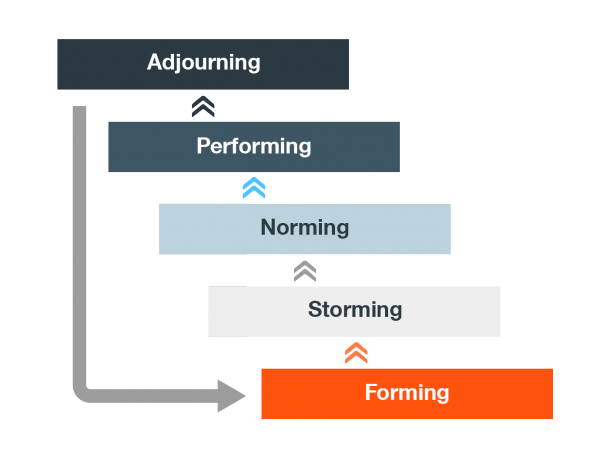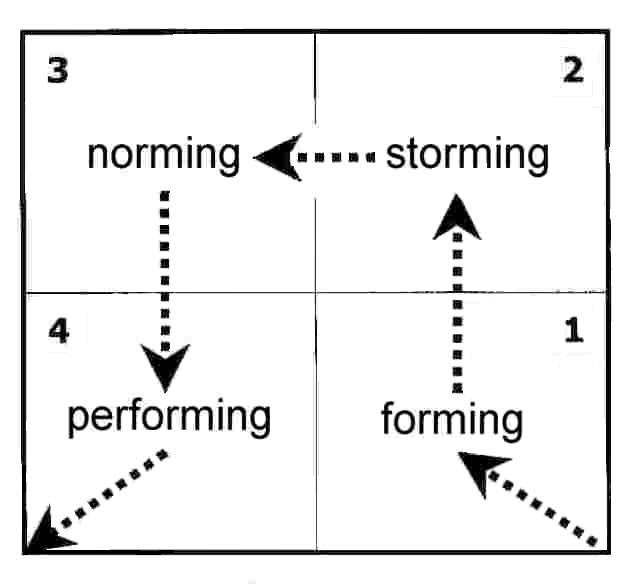

Bruce Tuckman innovated a solution to manage the team
In 1965, Bruce Tuckman – a human resources scientist- developed a model that Overcomes the obstacles which face the team building process, and we have mentioned some of them above. Tukman’s model which was later known as Tukman’s Ladder was initially based on 4 stages. In 1977, Tuckman, jointly with Mary Ann Jensen, added a fifth stage to the 4 stages: adjourning (Mourning), that involves completing the task and breaking up the team.
Tukman Ladder’s stages of group development
The goal of these five stages is building a team that can overcome the obstacles his work faced during work, solve problems, find solutions, make a plan and deliver the results.

1- Forming
It is the first stage of team building, the forming stage of any team is important because in this stage, the members of the team get to know one another, exchange some personal information, and make new friends. This is also a good opportunity to see how each member of the team works as an individual and how they respond to pressure. And actually it is preferred that the team manager introduces each member and explain why he was especially chosen for this work.
2- Storming
- Every group will next enter the storming stage in which different ideas compete and everyone believes that his idea is the one, a clash may happen between the team and here comes the role of team manager, he should try to reconcile the views of each member and show him that his opinion is important and it is right.
- In the Storming Stage, the team addresses issues such as what problems they are really supposed to solve, how they will function independently and together and what leadership model they will accept. Team members open up to each other and confront each other’s ideas and perspectives.
- In some cases, storming can be resolved quickly. In others, the team never leaves this stage. The maturity of some team members usually determines whether the team will ever move out of this stage. Some team members will focus on minutiae to evade real issues.
- This phase can become destructive to the team and will lower the motivation if it gets out of control.
3- Norming
- In the Norming Stage the team will be more harmonious and they will all agree to manage the work together in order to reach their goal. Some members may suggest a good idea that all the team will agree upon and this will help the team in their work.
- In this stage, all team members take responsibility and have the ambition to work for the success of the team’s goals. The role of the team manager is only supervising and giving members the required authority to make decisions.
4- Performing
- It is possible for some teams to reach the performing stage. These high-performing teams are able to function as a unit as they find ways to get the job done smoothly and effectively without inappropriate conflict or the need for external supervision.
- The team members are now competent, autonomous and able to handle the decision-making process without supervision. Dissent is expected and allowed as long as it is channeled through means acceptable to the team. Supervisors of the team during this phase are almost always participative. The team will make most of the necessary decisions.
- However, even the most high-performing teams will revert to earlier stages in some circumstances. Many long-standing teams go through these cycles many times as they react to changing circumstances. For example, a change in leadership may cause the team to revert to storming as new people challenge the existing norms and dynamics of the team.
Tuckman’s Model of Team Development Diagram
This a diagram of Tuckman’s four stages of team development. Below is an outline of the fifth stage, which Tuckman only added later after refining his theory.

Better quality diagrams are available as separate files here:
- Tuckman ‘Forming Storming’ diagram (doc format)
- Tuckman ‘Forming Storming’ diagram (pdf format)
Hersey and Blanchard’s Situational Leadership
The classic Situational Leadership® model of management and leadership style also illustrates the ideal development of a team from immaturity (stage 1) through to maturity (stage 4).
According to this model, the leadership style progressively develops from relatively detached task-directing
(1), through the more managerially-involved stages of explanation
(2) and participation
(3), to the final stage of relatively detached delegation
(4), at which time ideally the team is largely self-managing, and contains at least one potential management/leadership successor.
The aim of the leader or manager is, therefore, to develop the team through the four stages, and then to move on to another role.
The model also illustrates four main leadership and management styles, which a good leader is able to switch between, depending on the situation (i.e., the team’s maturity relating to a particular task, project or challenge).
Characteristics of Tukman’s Ladder
Tukman’s model is called Tukman’s ladder because:
- It consists of steps
- Each step depends on the previous one.
- Each step prepares for the performing stage.
- Skipping any step effects performing negatively.
- With every new challenge, the process is repeated
Background and Resources
- Situational Leadership® is a trademark of the Center for Leadership Studies, which represents the interests and products of Dr Paul Hersey. Ken Blanchard (who incidentally wrote ‘The One Minute Manager’) went on to develop the Situational Leadership® system into what he called Situational Leadership II®, and which now covers a range of products marketed by his organization, The Ken Blanchard Companies.
- Use of material relating to Situational Leadership® and/or Situational Leadership II® requires licence and agreement from the respective companies.
- For more detail on Leadership theories.
Team Norms and Cohesiveness
- When you have been on a team, how did you know how to act? How did you know what behaviors were acceptable or what level of performance was required? Teams usually develop norms that guide the activities of team members. Team norms set a standard for behavior, attitude, and performance that all team members are expected to follow. Norms are like rules but they are not written down. Instead, all the team members implicitly understand them. Norms are effective because team members want to support the team and preserve relationships in the team, and when norms are violated, there is peer pressure or sanctions to enforce compliance.
- Norms result from the interaction of team members during the development process. Initially, during the forming and storming stages, norms focus on expectations for attendance and commitment. Later, during the norming and performing stages, norms focus on relationships and levels of performance. Performance norms are very important because they define the level of work effort and standards that determine the success of the team. As you might expect, leaders play an important part in establishing productive norms by acting as role models and by rewarding desired behaviors.
- Norms are only effective in controlling behaviors when they are accepted by team members. The level of cohesiveness on the team primarily determines whether team members accept and conform to norms. Team cohesiveness is the extent that members are attracted to the team and are motivated to remain in the team. Members of highly cohesive teams value their membership, are committed to team activities, and gain satisfaction from team success. They try to conform to norms because they want to maintain their relationships in the team and they want to meet team expectations. Teams with strong performance norms and high cohesiveness are high performing.
- For example, the seven-member executive team at Whole Foods spends time together outside of work. Its members frequently socialize and even take group vacations. According to co-CEO John Mackey, they have developed a high degree of trust that results in better communication and a willingness to work out problems and disagreements when they occur.[1]
Is Team Effective or Not?
There are various indicators of whether a team is working effectively together as a group. The characteristics of effective, successful teams include:
- Clear communication among all members
- A regular brainstorming session with all members participating
- The consensus among team members
- Problem-solving done by the group
- Commitment to the project and the other team members
- Regular team meetings are effective and inclusive
- Timely hand off from team members to others to ensure the project keeps moving in the right direction
- Positive, supportive working relationships among all team members
Teams that are not working effectively together will display the characteristics listed below. The team leader will need to be actively involved with such teams. The sooner the team leader addresses issues and helps the team move to a more effective way of working together, the more likely the project is to end successfully.
- Lack of communication among team members.
- No clear roles and responsibilities for team members.
- Team members “throw work over the wall” to other team members, with lack of concern for timelines or work quality.
- Team members work alone, rarely sharing information and offering assistance.
- Team members blame others for what goes wrong; no one accepts responsibility.
- Team members do not support others on the team.
- Team members are frequently absent, thereby causing slippage in the timeline and additional work for other members.
Example of Moving Through the Five Stages of Group Development
Background and Team Members
A team has been pulled together from various parts of a large service organization to work on a new process improvement project that is needed to improve how the company manages and supports its client base. The team lead on this project is Sandra from the Chicago office who has 15 years experience as a project manager/team lead managing process improvement projects.
The other members of the team include:
- Peter: 10 years experience on various types of projects, expertise in scheduling and budget control (office location: San Diego)
- Sarah: 5 years experience as an individual contributor on projects, strong programming background, some experience developing databases (office location: Chicago)
- Mohammed: 8 years experience working on various projects, expertise in earned value management, stakeholder analysis and problem solving (office location: New York)
- Donna: 2 years experience as an individual contributor on projects (office location: New York)
- Ameya: 7 years experience on process improvement projects, background in developing databases, expertise in earned value management (office location: San Diego)
Sandra has worked on projects with Sarah and Mohammed, but has never worked with the others. Donna has worked with Mohammed. No one else has worked with other members of this team. Sandra has been given a very tight deadline to get this project completed.
Sandra has decided that it would be best if the team met face-to-face initially, even though they will be working virtually for the project. She has arranged a meeting at the New York office (company headquarters) for the entire team. They will spend 2 days getting introduced to each other and learning about the project.
These stages are described in the table below. Some key points to note are:
- Usually these stages occur in order.
- But teams can get stuck in a particular stage or regress to an earlier stage.
- Projects with team members who worked together in the past might skip a stage.
- The duration of a particular stage depends upon team dynamics, team size, and team leadership.
- Project managers should have a good understanding of team dynamics in order to move their team members through all stages in an effective manner.
The header row shows the five stages of team development in the Tuckman Ladder. The footer shows the leadership style that the project manager adopts in these stages.
| Forming | Storming | Norming | Performing | Adjourning |
|---|---|---|---|---|
| First stage of team developmentTeam members try to avoid controversies or conflictsTeam members mostly work independentlyTeam members begin to know each and form impressions | Has the most potential for conflictIs necessary for the growth of the team | Team members begin to work together and trust each other | Teams begin to function as a unitGet the job done smoothly and effectively without inappropriate conflict or the need for supervisionOnly some teams manage to get into this stage | Tasks are completedTeam breaks upTeam members move on to other assignments |
| Directing | Coaching | Participating | Laissez-Faire | Counseling |






